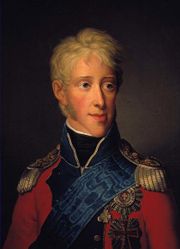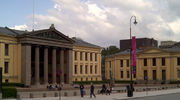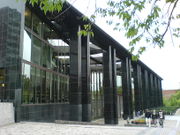University of Oslo
| University of Oslo (The Royal Frederick University) |
|
|---|---|
| Universitetet i Oslo (Det Kongelige Frederiks Universitet) |
|
| Latin: Universitas Osloensis (Universitas Regia Fredericiana) |
|
| Established | 1811 |
| Type | Public university |
| Rector | Professor Ole Petter Ottersen (2009-) |
| Academic staff | 2,800 (2007) |
| Admin. staff | 4,600 (2007) |
| Students | 25,617 (2008) |
| Location | Oslo, Norway |
| Campus | Urban |
| Affiliations | EUA |
| Website | www.uio.no |
The University of Oslo (Norwegian: Universitetet i Oslo, Latin: Universitas Osloensis) is the oldest, largest and most prestigious university in Norway, situated in the Norwegian capital of Oslo.
It was founded in 1811 as The Royal Frederick University (in Norwegian Det Kongelige Frederiks Universitet and in Latin Universitas Regia Fredericiana). The university was modelled after the recently established University of Berlin, and originally named after King Frederick of Denmark and Norway. It received its current name in 1939.
The university has faculties of (Lutheran) Theology, Law, Medicine, Humanities, Mathematics and Natural Sciences, Dentistry, Social Sciences, and Education. The Faculty of Law is still located at the old campus on Karl Johans gate, near the National Theatre, the Royal Palace, and the Parliament, while most of the other faculties are located at a modern campus area called Blindern, erected from the 1930s. The Faculty of Medicine is split between several university hospitals in the Oslo area.
Currently the university has about 27,000 students and employs about 4,600 people. It is considered one of the leading universities of Scandinavia, and has consistently been ranked among the world's top 100 universities by the Academic Ranking of World Universities; in 2009 it was ranked as the best in Norway, the 3rd best in the Nordic countries, the 18th best in Europe and the 65th best in the world[1] Also, in 2005 its Faculty of Humanities was ranked as the best in the Nordic countries, the 5th best in Europe and the 16th best in the world by the Times Higher Education Supplement.[2] In 2009, the university was ranked as the 101st best in the world by Times Higher Education[3].
Until the founding of the University in 1811, the University of Copenhagen was the only university of Denmark-Norway. After the dissolution of the Dano-Norwegian union in 1814, close academic ties between the countries have been maintained. The University of Oslo was the only university in Norway until 1946, and hence informally often known as simply "The University".
The University of Oslo is home to five Nobel Prize winners, with one of the Nobel Prizes (the Nobel Peace Prize) itself being awarded in the city of Oslo, close to the Faculty of Law.
Contents |
Units

Faculty of Theology
Faculty of Law
- Norwegian Research Center for Computers and Law (NRCCL) [1]
- Department of Criminology and the Sociology of Law [2]
- Department of Private Law [3]
- Department of Public and International Law [4]
- Section for Information Technology and Administrative Systems (SITAS) [5]
- Scandinavian Institute of Maritime Law [6]
- Centre for European Law [7]
- Norwegian Centre for Human Rights [8]


Faculty of Medicine
- Institute of Basic Medical Sciences
- Institute of General Practice and Community Medicine
- Institute of Psychiatry
- Psychosocial Centre for refugees
- Institute of Health Management and Health Economics
- Institute of Nursing and Health Sciences
- Faculty Division Aker University Hospital
- Faculty Division Akershus University Hospital
- Faculty Division Rikshospitalet
- Faculty Division Ullevaal University Hospital
- Faculty Division The Norwegian Radium Hospital
- Centre for Molecular Biology and Neuroscience
- Centre for Immune Regulation
- Centre for Cancer Biomedicine
Faculty of Humanities
- Department of Archaeology, Conservation and History [9]
- Department of Cultural Studies and Oriental Languages [10]
- Department of Philosophy, Classics, History of Art and Ideas [11]
- Department of Literature, Area Studies and European Languages [12]
- Department of Linguistics and Scandinavian Studies [13]
- Department of Media and Communication [14]
- Department of Musicology [15]
- Unit for Digital Documentation [16]
- Centre for Ibsen Studies [17]
- Centre for the Study of Mind in Nature [18]
- The Norwegian University Centre in St. Petersburg [19]
- The Norwegian Institute in Rome [20]
- Centre for French-Norwegian research cooperation within the social sciences and the humanities [21]
Faculty of Mathematics and Natural Sciences
- Department of Biology [22]
- Department of Molecular Biosciences [23]
- School of Pharmacy [24]
- Institute of Theoretical Astrophysics [25]
- Department of Physics [26]
- Department of Informatics [27]
- Department of Geosciences [28]
- Department of Chemistry [29]
- Department of Mathematics [30]
- Department of Physics of Geological Processes [31]
- Centre for Theoretical and Computational Chemistry
- Centre of Mathematics for Applications [32]
- Centre for Ecological and Evolutionary Synthesis [33]
- Centre for Materials Science and Nanotechnology [34]
- Centre for Entrepreneurship [35]
Faculty of Dentistry
- Department of Oral Biology
- Institute of Clinical Dentistry
Faculty of Social Sciences
- Department of Sociology and Human Geography [36]
- Department of Political Science [37]
- Department of Psychology [38]
- Department of Social Anthropology [39]
- Department of Economics [40]
- Centre for technology, innovation and culture [41]
- ARENA - Centre for European Studies [42]
Faculty of Education
- Department of Teacher Education and School Development
- Department of Special Needs Education
- Institute for Educational Research
- The Autism Unit
- Centre for Interdisciplinary Studies in New Media and Communication Technology
University Library
- Library of Medicine and Health Sciences
- Library of Humanities and Social Sciences
- Faculty of Law Library
- Faculty of Mathematics and Natural Sciences Library
Units directly under The Senate
- The Biotechnology Centre of Oslo
- Center for Women's Studies and Gender Research
- Centre for Development and the Environment
- International Summer School[43]
Museums
Museum of Cultural History
- The Historical Museum
- Collection of Coins and Medals
- Ethnographic Museum
- The Viking Ship Museum
Natural History Museum
- Natural History Museum at the University of Oslo
- Mineralogical-geological Museum
- Paleontological Museum
- Zoological Museum
- Botanical Garden
- Botanical Museum
People
Rectors
Nobel laureates
Five researchers at the University of Oslo have been awarded Nobel Prizes:
- Fridtjof Nansen - 1922 - Peace (Although it was not Nansen's scientific work that earned him the prize.)
- Ragnar Frisch - 1969 - Economics
- Odd Hassel - 1969 - Chemistry
- Ivar Giæver - 1973 - Physics
- Trygve Haavelmo - 1989 - Economics
Faculty
- Magnus Aarbakke, Professor of Law 1968-1990, Justice of the Supreme Court of Norway 1994-2002 (b. 1934)
Alumni
- Eduard Boeckmann, Medical (1882)
- Hjalmar Hjorth Boyesen, Ph.D. (1868)
- Viggo Brun, Mathematics
- Gro Harlem Brundtland, Medicine (1963)[44]
- Johannes Wilhelm Christian Dietrichson, Theology (1837)
- Svein Gjedrem, Economics (1975)[45]
- Nicolai A. Grevstad, Law (1878)
- Kristofer Janson, Theology (1865)
- Ulrik Vilhelm Koren, Theology (1852)
- Peter Laurentius Larsen, Theology (1857)
- Sophus Lie, Mathematics
- Trygve Lie, Law (1919)
- Geir Lundestad, History
- Peter Andreas Munch, Law (1838)
- Arne Næss, Philosophy
- Herman Amberg Preus, Theology (1848)
- Thoralf Skolem, Logic
- Jens Stoltenberg, Economics (1987)[46]
- Carl Størmer, Mathematics
- Jan P. Syse, Law
- Odd Arne Westad, Philosophy
Seal

The seal of the University of Oslo features Apollo with the Lyre, and dates from 1835. The seal has been redesigned several times, most recently in 2009. The former design dates from the 1980s.[4]
Student life
Like all public institutions of higher education in Norway, the university does not charge tuition fees. However, a small fee of NOK 410[5] (roughly US$70) per term goes to the student welfare organisation Foundation for Student Life in Oslo, to subsidise kindergartens, health services, housing and cultural initiatives, the weekly newspaper Universitas and the radio station Radio Nova.
Rankings
Academic Ranking of World Universities
| Year | Rank |
|---|---|
| 2003 | 63 |
| 2004 | 68 |
| 2005 | 68 |
| 2006 | 68 |
| 2007 | 69 |
| 2008 | 64 |
| 2009 | 65 (best in Norway, 3rd best in the Nordic countries, 18th best in Europe) |
THE–QS World University Rankings
| Year | Rank (Change) |
|---|---|
| 2004 | 101 |
| 2005 | 138 ( |
| 2006 | 177 ( |
| 2007 | 188 ( |
| 2008 | 177 ( |
| 2009 | 101 ( |
Webometrics Ranking of World Universities
| Year | Rank |
|---|---|
| 2007 | 48 |
| 2008 | 50 |
| 2009 | 55 (2nd best in Norway, 3rd best in the Nordic countries, 7th best in Europe) |
See also
- Higher education in Norway
References
- ↑ http://universitas.no/nett/54046/universitetet-i-oslo-er-verdens-65-beste-universitet/
- ↑ Uniforum nett no - HF-fakultetet er i verdstoppen
- ↑ http://www.uniforum.uio.no/nyheter/2009/10/uio-femte-beste-i-norden.html
- ↑ http://universitas.no/nett/54264/universitetet-i-oslo-far-nytt-design/
- ↑ "Semesteravgift" (in Norwegian). University of Oslo. 2009-04-21. http://www.uio.no/studier/studentweb/semesteravgift.html. Retrieved 2010-04-20.
External links
- The University of Oslo website
- The Foundation for Student Life in Oslo (Studentsamskipnaden)
- Universitas (student newspaper)
- Radio Nova (student radio)
|
|||||
|
||||||||||||||||